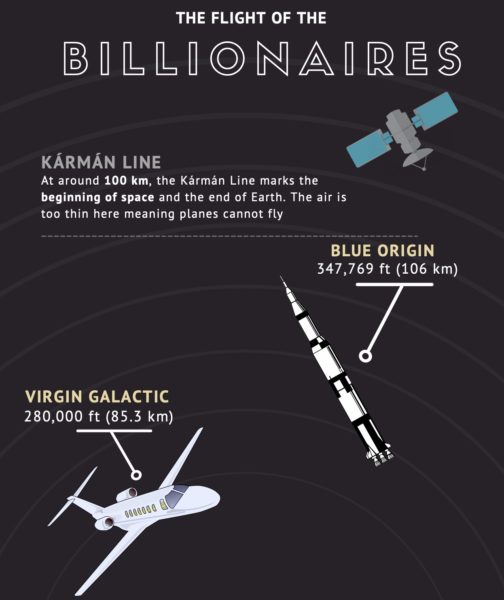

April 12, 1961: Yuri Gagarin is the first man in space; July 20, 1969: Neil Armstrong is the first man to walk on the moon; November 20, 1998: The building of the International Space Station commences as the first segment is launched.
Each of these dates stands as a landmark to humanity’s leaps in exploring the frontier of space. Needless to say, although the vastness of space holds many unknowns, the prospect of experiencing it is no longer out of the question — at least for some, that is.
July 11 marked the 90 minute manned space flight of Virgin Galactic’s founder Richard Branson, who after 17 years of preparation, was able to achieve an altitude of approximately 280,000 feet, surpassing the Earth-space border. Jeff Bezos, founder and executive chairman of Amazon, the parent company of Blue Origin, tailed behind Branson on July 20. The crew was able to reach 347,769 feet, surpassing the Kármán line, the point in space where normal aircrafts cannot fly due to the thin air.
Human spaceflight isn’t the primary objective of a certain billionaire, however. Elon Musk, CEO of SpaceX and Tesla, has already set his sights on much deeper space observation. Although Musk bought a ticket for a Virgin Galactic flight, he made it clear that his main concern is the colonization of Mars. Similarly, Bezos sees spaceflight as a stepping stone for the eventual colonization and wider accessibility of space.
The goals of all three do coincide though; human spaceflight, tourism and extraterrestrial colonization all make one thing clear: the commercialization of space is rapidly expanding, whether we like it or not.
“The commercialization of space is rapidly expanding, whether we like it or not”
The idea of traveling to space is an intriguing one, and for many, a childish fantasy. Who wouldn’t want to experience the sci-fi novels of spaceships traveling at light speed? In that way, travel to space has become another once in a lifetime activity.
Yet, where do we draw the line between recreation and the outlandish? The market for space tourism stands only as a glamorous joyride for the rich. The true remarkable nature of space shouldn’t be boiled down into three minutes of floating around in zero gravity.
In essence, the billionaire space race has begun as executives battle to reach the highest altitudes and expand space to consumers the fastest. That is the simple truth for now, and likely for years to come: it’s a billionaire space race, not one of the ordinary constituent.
Particularly, as NASA opens the space station to the private sector, the price of a single flight can reach upwards of $55 million. Virgin Galactic has announced flights in early 2022 to the edge of space will cost $250,000. Although the offer does have 600 individuals lined up, some since as early as 2013, the price tag stands as a firm barrier.

Exorbitant prices aside, the commercialized space sector is set to grow over the coming years. Currently valued at $336 to $350 billion, the industry is set to generate more than $1 trillion in revenue in 2040, according to Morgan Stanley, one of the largest investment firms based in New York. Private companies range anywhere from companies such as Virgin Galactic or Boeing that invest in space flight and its commercialization, to companies like Aerojet Rocketdyne that focus on developing military devices for space.
That being said, private versus public involvement in space exploration has proven to be vastly different. Governmental space exploration has almost always been for research. This funding has allowed public bodies to make advancements and focus on research which may not be as applicable to private entities due to poor return. Investment in knowledge just isn’t enough to maintain a company, or even an industry, explaining why companies must choose their focus wisely when it concerns space.
Innovations have come out of these private exploits nonetheless. SpaceX was recently able to develop their booster return technology that allowed them to safely return rockets back to Earth and be reused, saving millions of dollars. Many times, innovation is certainly driven by profit, although as of now, it is beginning to feel like this drive overpowers the need for further innovation.
Equity in space in the form of ownership also comes into question as commercial space flight becomes more plausible. As of now, the edge of space does not fall under governmental jurisdiction. In 1963, the United Nations General Assembly outlined that no nation would be allowed to claim ownership of space and that space exploration is open to all states. As the area becomes accessible, however, the lack of regulations currently set in place ultimately come into question.



